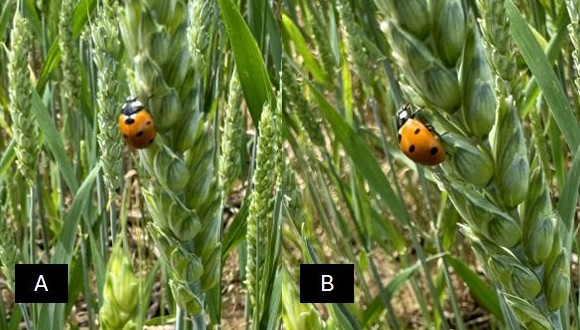Sevenspotted Lady Beetle Population Surged During First Week of May 2025
Sevenspotted Lady Beetle Population Surged During First Week of May 2025

One lady beetle species may have increased due to the abundance of aphids in wheat. This personal observation is based on my visits to wheat fields in western Kentucky. The population of the seven-spotted lady beetle (or C7), Coccinella septempunctata (Coleoptera: Coccinellidae) (Figures 1A, 1B, 1C, and 1D), appears to be the most abundant coccinellid species in small grain fields across Kentucky this time of the year. This species was called the “Old World ladybird” by European entomologists for over 600 years, and it is found in Europe and Asia.
History of this Lady Beetle
The seven-spotted lady beetle was released in 1958 in several states. However, it was not found until 1973 (in New Jersey); since then, seven-spotted lady beetle has become well established in the U.S. and nowadays is one of the most dominant predators of aphids found in many states and Canada. This species has been implicated in the displacement of native coccinellid species, such as Coccinella novemnotata (the nine-spotted lady beetle, or C9).
The Situation in Kentucky
From 2016 to 2024, I recorded that the most abundant lady beetle species between March and May were the pink lady beetle (Coleomegilla maculata), a native species, and the multicolored Asian lady beetle (Harmonia axyridis), an introduced species from Asia. However, the seven-spotted lady beetle was not found in great numbers.
Last week, I reported a sudden increase in the English grain aphid (Sitobion avenae) population in the KPN article “Aphids Landing on Small Cereals a Little Bit Late to Cause Major Concerns.” The surge in seven-spotted lady beetle occurring this year may coincide with the increased abundance of the English grain aphid, although this lady beetle species is known to feed on as many as 24 aphid species in North America.
Relationship between the Lady Beetle & Aphids
A study in India found a relationship between the population dynamics of the English grain aphid and various developmental stages of the seven-spotted lady beetle. It revealed that all life stages of the beetle contributed collectively to reducing the aphid population.
The relationship described between the seven-spotted lady beetle and English grain aphid may be influenced by subjective perceptions and temporal environmental conditions rather than a well-planned scientific approach. Nevertheless, documenting this relationship is important as it can guide more detailed future studies.

Figure 1. The sevenspotted lady beetle: (A) dorsal view, (B) lateral view, (C) a morph with more intense dark-orange coloration, and (D) a nymph. [Photos: F. Batista, UK (A & B), and Raul Villanueva, UK (C & D)].
More Information
- University of Florida, Publication #EENY170: Ladybirds, Ladybird beetles, Lady Beetles, Ladybugs of Florida, Coleoptera: Coccinellidae
- Hodek, I. and J.P. Michaud. 2008. Why is Coccinella septempunctata so successful? (A point-of-view). Eur. J. Entomol. 105: 1–12,
By Raul T. Villanueva, Entomology Extension Specialist

